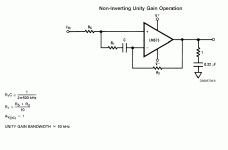Hi,
I am thinking about using LM1875 or equivalent power opamps to drive Grado headphones. I am hoping that it might well be operating in Class-A at ear-splitting volume.
The main concern is that it might blow the cans. But what if I operated the opamp at fairly low gain such as 1 ~ 3. I found a following schematics in LM675 specs.
I am wondering if I can use this with LM1875. Also, I am wondering if I were to attack another resistor to the feedback resistor to fix up gain other than 1.
Thanks,
Tomo
I am thinking about using LM1875 or equivalent power opamps to drive Grado headphones. I am hoping that it might well be operating in Class-A at ear-splitting volume.
The main concern is that it might blow the cans. But what if I operated the opamp at fairly low gain such as 1 ~ 3. I found a following schematics in LM675 specs.
I am wondering if I can use this with LM1875. Also, I am wondering if I were to attack another resistor to the feedback resistor to fix up gain other than 1.
Thanks,
Tomo
Attachments
Oh,
And, I would be appreciated if you can tell me how this is proper when the chip is not unity gain stable?
Seems like snubber inserted between the inputs ... am I wrong?
Tomo
And, I would be appreciated if you can tell me how this is proper when the chip is not unity gain stable?
Seems like snubber inserted between the inputs ... am I wrong?
Tomo
I'm wondering why it's OK to put a series resistor in line with 8 ohm headphones. Won't this screw up the damping?
1) Per the datasheet, the minimum gain for LM1875 & LM3886 is 10. Then the fastest and easiest way to drop power is to use resistor in series with headphones. For 8 ohms, use 330.
There may be a more "correct" or eligant way, I don't know of one.
1) It may "technically" screw up the damping.
2) Try it, and let us know if it does.
There may be a more "correct" or eligant way, I don't know of one.
1) It may "technically" screw up the damping.
2) Try it, and let us know if it does.
Tomo said:Hi,
I am thinking about using LM1875 or equivalent power opamps to drive Grado headphones. I am hoping that it might well be operating in Class-A at ear-splitting volume.
The main concern is that it might blow the cans. But what if I operated the opamp at fairly low gain such as 1 ~ 3. I found a following schematics in LM675 specs.
I am wondering if I can use this with LM1875. Also, I am wondering if I were to attack another resistor to the feedback resistor to fix up gain other than 1.
Thanks,
Tomo
It should work. You can add a res between -In and GND to change the gain. R2/R1 should be bigger than 10 (so that LM1875 is stable). The cap, use someting like 1uF.
Hi,
I don't want to be limited by the guidelines. Besides according to this schematics, you can have it operating at UNITY gain.
I want to know how the snubber connected across the inputs will bring stability to opamp which isn't unity gain stable.
Tomo
I don't want to be limited by the guidelines. Besides according to this schematics, you can have it operating at UNITY gain.
I want to know how the snubber connected across the inputs will bring stability to opamp which isn't unity gain stable.
Tomo
Rather than dropping things with an output series resistor, why not use a 10:1 voltage divider at the input?
Tomo said:Hi,
I want to know how the snubber connected across the inputs will bring stability to opamp which isn't unity gain stable.
Tomo
http://www.diyaudio.com/forums/showthread.php?s=&threadid=25515
Hi,
I read the paper and I realized something. Appearently, this method reduce the actual "signal" gain to unity, however, noise gain stays at the minimum gain within some certain bandwidth.
That means G=10 applied to noise, but the signal goes through without gain. I am worried that such increase in noise level may be very bad ...
Help me, oh so great ones of the hall of wise!
Tomo
I read the paper and I realized something. Appearently, this method reduce the actual "signal" gain to unity, however, noise gain stays at the minimum gain within some certain bandwidth.
That means G=10 applied to noise, but the signal goes through without gain. I am worried that such increase in noise level may be very bad ...
Help me, oh so great ones of the hall of wise!
Tomo
Tomo,
The OPA power op-amps from Burr-Brown are unity-gain stable.
No fuss.
You can try the OPA548.😉
The OPA power op-amps from Burr-Brown are unity-gain stable.
No fuss.
You can try the OPA548.😉
- Status
- Not open for further replies.
- Home
- Amplifiers
- Chip Amps
- Unity Gain Operation (or low gain)
